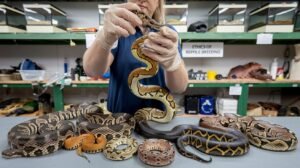When it comes to our furry friends, providing them with the right nutrition is paramount for their well-being. This article delves deeper into natural dog food, homemade cat food, pet vitamin supplements, a balanced diet for dogs, and foods toxic to pets. Understanding each aspect is essential for optimizing the health of our pets and offering them a happy, vibrant life.
Natural Nourishment for Canine Companions
Natural dog food emphasizes whole, real ingredients that align with the canine omnivorous diet, blending meats, vegetables, and grains in proportions that mirror what dogs would have historically consumed. This diet supports optimal health by providing a wide range of nutrients in forms easily absorbed by a dog’s body. When selecting a natural food for your dog, consider age, breed, and health status, as these factors influence dietary needs. Younger dogs and those with active lifestyles may require more protein and calories, while senior dogs benefit from diets lower in calories but rich in fiber to aid digestion. Additionally, some breeds have specific health concerns that can be managed with targeted nutrition, such as joint support for large breeds or formulas that promote heart health for breeds prone to cardiac issues.
The domestication of dogs has not significantly altered their basic dietary needs from their wild ancestors, who consumed a varied diet of meats, bones, organs, and even pre-digested plant matter from their prey’s stomach. Modern natural dog foods strive to replicate this balanced approach, often including muscle meat, organ meats, whole or ground bones, and a selection of fruits and vegetables to provide a spectrum of vitamins, minerals, and antioxidants. The commercial natural dog food market has grown substantially as pet owners seek diets that promote longevity and reduce the risk of chronic diseases like obesity, diabetes, and allergies, which can be exacerbated by processed foods.
Transitioning to a natural diet can have immediate and long-term benefits for a dog’s health, including improved coat condition, better digestive health, reduced allergy symptoms, and more stable energy levels. However, it’s crucial to select a natural dog food that meets the Association of American Feed Control Officials (AAFCO) standards, ensuring the food is complete and balanced for the intended life stage of the dog. This careful selection helps avoid nutritional deficiencies or excesses that can occur with less regulated diets.
In the historical context, dogs thrived on a variety of natural foods based on what was available in their environment, from fish in coastal areas to game animals in forested regions. This adaptability to different food sources has been a key factor in the successful domestication of dogs, and modern natural diets seek to honor this heritage. As the market for natural dog food has expanded, so too has the accessibility of high-quality, commercially prepared diets that take the guesswork out of feeding a natural diet. This shift towards natural nutrition marks a return to the basics of canine dietary needs, prioritizing the health and wellbeing of dogs through diet, much as our ancestors did.
Preparing Wholesome Meals for Feline Friends
Cats, as obligate carnivores, possess specific dietary needs that set them apart from many other pets, including dogs. Unlike animals with more omnivorous diets, cats require high levels of protein, and certain nutrients like taurine and Vitamin A must be readily available in their diet. These nutrients are not merely beneficial but are critical for preventing heart disease, vision problems, and reproductive issues.
In preparing homemade cat food, owners must ensure these nutritional needs are met, taking into account that cats cannot convert beta-carotene to Vitamin A in the same effective manner humans and some other animals can. This necessitates sourcing ingredients rich in animal-based Vitamin A, such as liver. Furthermore, taurine, an amino acid found predominantly in muscle meat and organs, must be included in sufficient quantities. Despite the enrichment of these essential nutrients in many commercial cat foods, the preparation of a balanced homemade meal can offer a fresher, preservative-free alternative, giving the owner full control over their feline’s diet.
The history of feline diets reveals a significant evolution in our understanding of cat nutrition. Previously, it was common to feed cats a diet heavily reliant on human food scraps, which often failed to meet their nutritional requirements. This practice stemmed from misconceptions about feline dietary needs. Modern knowledge underscores the importance of a meat-based diet tailored to their physiological demands.
In practical terms, meal preparation for cats should lean heavily on variety to mimic the range of nutrients they would naturally obtain from different prey. This can include a rotation of chicken, beef, rabbit, and fish, supplemented with liver and other organ meats to provide a comprehensive nutrient profile. Meal frequency is also vital, with most adult cats thriving on two meals per day.
However, transitioning to a homemade diet should be approached with caution. Sudden dietary changes can disrupt a cat’s digestive system. Gradually introducing new foods allows for observation of any adverse reactions. Consulting with a veterinarian or a feline nutritionist can provide guidance tailored to an individual cat’s health needs, ensuring that the homemade diet supports optimal health without inadvertently omitting crucial nutrients.
Supplements and Safety in Pet Diets
The nuanced realm of pet vitamin supplements underscores a critical balance in canine nutrition. While vitamins and minerals are indispensable to a dog’s health, embodying roles from bone development to nerve function, the menace of hypervitaminosis looms for those pets subjected to excessive supplementation. Particularly, fat-soluble vitamins such as A and D, which are stored in the body’s fat and liver, pose a significant risk when ingested in large quantities, leading to a range of health issues including bone deformities and muscle atrophy.
A balanced diet for dogs, as recommended by the World Health Organization (WHO) and the United States Department of Agriculture (USDA), should ideally meet all the nutritional requirements of a pet, mitigating the need for additional vitamin supplementation. These guidelines emphasize a diet that includes a proportional blend of proteins, carbohydrates, fats, vitamins, and minerals, drawing on a variety of sources to ensure a comprehensive intake of essential nutrients.
Micronutrients, in particular, play a pivotal role in maintaining a dog’s health, aiding in processes such as blood coagulation and enzymatic reactions. A balanced diet, rich in leafy greens, lean meats, and healthy fats, for instance, can furnish a pet with the necessary vitamins and minerals, such as calcium and phosphorous for bone strength, and B vitamins for energy metabolism. Such a diet obviates the need for supplementary vitamins, preserving the pet’s health while preventing the potential toxicity associated with hypervitaminosis.
To cement the importance of dietary safety, a discourse on foods toxic to pets is pivotal. Common household foods such as chocolate, grapes, onions, and garlic pose significant risks to dogs and cats alike. The science behind these dangers often links back to specific compounds within these foods – for example, theobromine in chocolate, which dogs process much more slowly than humans, leading to potential toxicity. Similarly, compounds in onions and garlic can cause oxidative damage to red blood cells, resulting in anemia in pets. Understanding these risks underscores the importance of adhering to a diet formulated specifically for pets, steering clear of human foods that, despite being healthy for us, may be perilous for them.
This holistic approach to pet nutrition, mindful of the balanced dietary needs and the hazards presented by certain foods and excessive supplementation, ensures the well-being of our canine companions, fostering a healthy, vibrant life.
Conclusions
Ensuring a well-rounded diet for our pets is critical for their health and longevity. Natural and homemade options can offer quality nutrients, while the right supplements fill any dietary gaps. However, vigilance is important to protect them from toxic foods. A clear understanding of nutrition helps foster a strong, loving bond with our furry family members.



